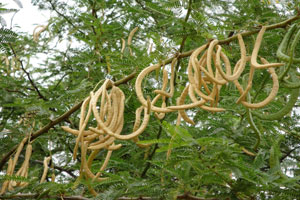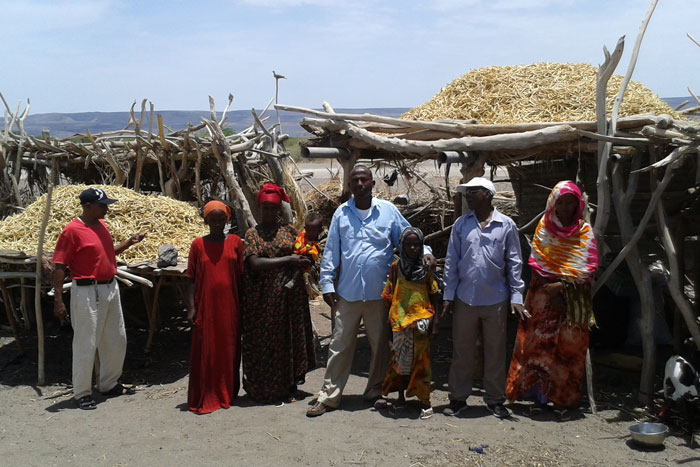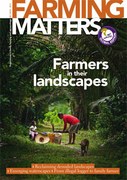Millions of hectares of once degraded dustbowls across the world’s drylands have become ‘reforested’ in recent decades. The landscape has totally changed, but the trees were not planted. Exotic trees have spread ‘naturally’, creating dense forests over large areas. Local farmers and pastoralists must be happy then? Not at all. The trees have actually made their lives worse, invading pastures, as a weed in farmland, blocking paths and roads, and they have even forced some communities to relocate. But through the sharing of experiences from country to country, more people are learning how to make the most from this new resource, as this story from Djibouti shows.
From desert to forest
Prosopis – valuable resource or invasive weed?
In tropical dry areas of Africa and Asia, one species stands out – Prosopis juliflora. It was widely planted in the 1980s as part of reforestation programmes, and quickly spread, creating dense and impenetrable thickets in agricultural, pasture and natural areas. It out competes native species and forage plants, is very thorny, and can completely block paths and roads. But in its native American range, prosopis are appreciated as valuable trees, especially for their sweet and protein-rich golden-yellow pods which are ground into flour for making animal feeds or human food.
The wood and charcoal is of high quality, posts and poles are marketed, and the heartwood is very hard indeed making excellent flooring and furniture. Prosopis honey fetches a premium price, the resin is equivalent to gum Arabic, and all plant parts have medicinal uses. It is also a nitrogen fixing tree that improves the fertility of surrounding soil, and provides good shade, shelter and erosion control.
Most of the planted trees died and most of the native trees that were left were cut down for firewood. Sandstorms became more common. Poor soils and lack of experience meant harvests were meagre.
In the 1990s, civil war came and went, and many left for the city, or abroad if they could. But better rains came and some managed to improve their yields. The one introduced tree species that did survive began to spread, thanks to animals eating the pods and its ability to grow in the harsh desert climate.
In only a few years, large areas became covered with a mass of thorny thickets. A decade later, thickets turned into forests covering hundreds of hectares. The invasion of prosopis trees had begun.
But the wrong trees
In 2013, it was estimated that some 60,000 hectares of this small nation was covered by prosopis. And half of this is around Hanlé, where prosopis had become a huge problem for the community, having invaded huge swaths of agricultural and pasture land. The same problem is also shared by many people in other countries.
There is thought to be a million hectares of invaded prosopis in neighbouring Ethiopia, the same amount in Kenya, Sudan and Australia, two million in South Africa, five million in India, and millions more in Brazil, Mexico and the USA, Pakistan and Sri Lanka, from Senegal to Somalia, in eastern and southern Africa, and numerous island states. Prosopis is classified amongst the ‘world’s worst alien invasive species’, and is a legally declared national weed in many countries.
However, prosopis trees and ‘forests’ also produce a multitude of resources, some of which are already used to some small extent but most remain very much underutilised. Since the 1990s a small but growing group of professionals have been developing and promoting an innovative approach of ‘control by utilisation’ as a win-win solution to address this dilemma of how to manage a useful but invasive species. The aim is to turn this unappreciated tree into a source of valuable products to help alleviate poverty and improve food security in dry areas, while at the same time reducing its negative ecological and social impacts.
The need for knowledge

Known as mesquite or algarrobo in their native Americas, prosopis has been introduced around the world since the 1800s. They were seen as useful, fast growing and drought tolerant trees that could provide fuel, fodder and shade, but whereas the trees were successfully introduced, the indigenous knowledge on how to manage and fully utilise them was not.
In the late 1990s, experts from Argentina, Peru and Mexico were brought to India to show people there the many uses of prosopis trees and ways to process them, such as how to mill the pods and how to saw the often twisted logs.
The experience gained was then transferred to Kenya some years later, where it took hold. Government policies changed and many businesses sprung up, with an estimated million US dollars per year now added to the collective incomes of selected communities through the sale of prosopis charcoal and pod flour. A ‘green’ power station is also being built in Kenya that will supply 5 MW of electricity by burning prosopis wood alone, based on a model in use in India.
And on to Djibouti
Thanks to the pioneering vision of Mohamed Awale, then Secretary of State for National Unity and now Minister of Agriculture, successive visits were made to transfer this knowledge to Djibouti beginning in 2008 and later supported by UNDP.
Beginning in 2012, the FAO as part of a Technical Cooperative Programme assisted the government in providing four communities with equipment and training so they could better manage and utilise the ‘free’ prosopis resource growing ever larger around them. Pod milling machines from India that were tested and proved successful in Kenya were imported and installed along with improved charcoal kilns.
Tools and protective clothing for managing thorny stands were also supplied, and training was given on stand management of invasive stands, and the operation and maintenance of these new technologies.
The cooperative in Hanlé took up this opportunity with both hands. In 2013, they organised the collection of almost six tonnes of pods from over a wide area and brought them all to the site of the mill.
Much of the milled pod flour was given out to cooperative members for mixing and feeding to their own livestock, and the people saw how the animals appreciated it, growing strong and with better milk yields. The cooperative was especially happy with their first sale of milled flour, of 110 (25 kg) sacks that were sold to livestock producers for FD1500 each (or a total of almost US$1000). There was strong demand for more, with buyers saying that it was a very nutritious, competitively priced and locally sourced concentrate that replaced some of the expensive, imported feeds that they currently rely on.
Ali Hamad said that the cooperative would certainly take up the pod processing technology and wanted to increase production from last year’s ‘experiment’. They would invest in fuel, oil and empty sacks, had already identified 10 families in each of the three main prosopis area to lead the pod collection, and would use their own cash reserves to pay FD300 for every 10 kg sack of pods collected. If production only equals that of 2013, this would mean that collectors in the local area, mostly women, would receive a total of about US$1000 thanks to the development of prosopis pod flour as a new value-added product. A neighbouring community on Gob’aad is also planning to make more use of prosopis, but they see more benefits from charcoal than from the pods. Beekeeping is another avenue worth further exploration.
Landscape management
Benefits from milling prosopis pods
When eaten whole, the hard seeds pass through the animals’ gut undigested, and germinate into new invasive plants. In the dry season when the sweet pods may be the only forage available, the sugars also tend to cause tooth decay and stomach disorders in livestock, and some animals even die. And most of the protein is in the seed, which is then ‘wasted’. By processing the pods, not only is the seed protein made available for the animals to digest, it is easier to mix, and some two million seeds are destroyed for every tonne of pods that are milled. The pod flour is also used a nutritious ingredient in human foods in its native Americas but it not eaten in Africa.
Ali also told of a recent meeting between livestock owners and charcoal makers in the area, which resulted in an agreement on the future management of dense prosopis thickets. The causal issue was the death of seven camels due to attacks by hyenas. Whereas small livestock are corralled at night, camels are left to roam freely but are normally able to evade attack. Now, however, many paths have become blocked by encroaching thorny prosopis and hyenas are able to corner camels and kill them.
Camel owners asked if charcoal makers could clear roads through the dense stands as they cut wood for charcoal instead of just clearing blocks of trees as they usually do. They agreed. This is an excellent example of different interest groups within a community being able to agree a common approach to natural resource management in a changing environment, for everyone’s mutual benefit.
Introducing new tree species or any other crop is not enough, if the traditional knowledge on how it is best used does not accompany it. Though as is seen from this example, the knowledge can come along later, and will be adopted if it is appropriate for the locality. With invasive plants, there is the added advantage that the resource is effectively ‘free’, and there is much potential for adapting the ‘control by utilisation’ approach for other weeds. Also, this case shows how knowledge from the native range been adapted in steps for each situation, and also the importance of committed development professionals in ensuring that ideas make it out into the hands of farmers.
Before leaving the shade of the doum palm, Ali Hamad summed up their experience. “Before, we didn’t know what we could do with prosopis pods, but then we milled it, people took the flour home, mixed it and gave it their animals. They ate it with relish, and now we have started selling prosopis pod flour – the pods have really become ‘gold’ for us.”
Simon Choge and Nick Pasiecznik
Simon Choge works for the Kenya Forestry Research Institute (KEFRI), Marigat, Kenya.
Email: skchoge2002@yahoo.com
Nick Pasiecznik works for ILEIA, with a lifelong interest in dryland agroforestry.


